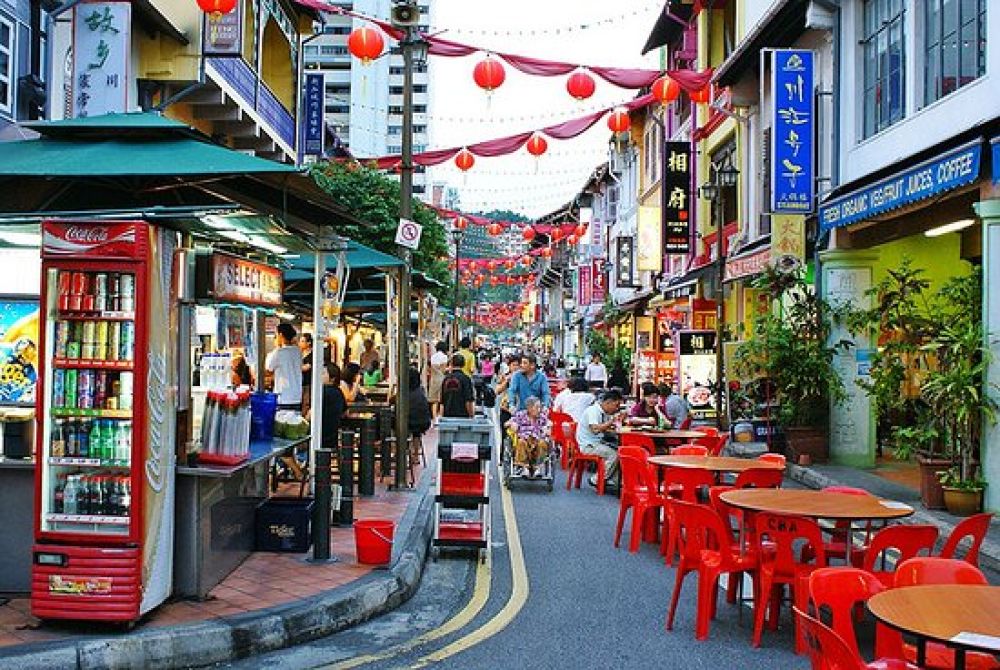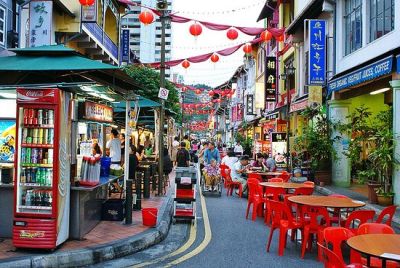

The Chinatown Heritage Centre is an essential stop for anyone looking to understand the rich history of the area. Located on Pagoda Street within a trio of beautifully restored shophouses, the center provides a deep dive into the lives of early Chinese migrants. A visit here transports you back to the late 19th and early 20th centuries, showcasing the struggles and aspirations of Chinatown’s first residents. Detailed exhibits include reconstructed living quarters and street scenes, as well as multimedia displays. The narrative is both enlightening and touching, leaving visitors with a profound appreciation for Singapore's cultural tapestry.
Indulge in a culinary adventure while exploring the vibrant food scene of Chinatown Street Market. Home to a wide array of street food stalls and heritage eateries, you can taste local specialties like Hainanese Chicken Rice, Char Kway Teow, and Satay. Beyond savoring the flavors, you'll learn about the history and culture behind these iconic dishes. Vendors often use recipes passed down through generations, making this experience a delicious connection to Singapore's past. Foodies shouldn't miss the opportunity to try the Michelin-starred Hawker Chan's soy sauce chicken rice or the famous chili crab from one of the local zhi char stalls.
When the sun sets, the night market in Chinatown comes alive with a different energy. Stalls light up, offering everything from souvenirs and traditional crafts to trendy accessories. The air is filled with a mix of aromas from street food vendors, beckoning visitors to try local snacks and sweets. Walking through the bustling lanes, you might also find live street performances or musicians, adding to the lively ambiance. Exploring the night market not only offers a chance to find unique gifts but also to immerse yourself in the local nightlife culture of Singapore's Chinatown.
The Buddha Tooth Relic Temple is a remarkable four-story temple and museum complex that has fast become one of Chinatown's defining landmarks. Visitors are welcomed by the imposing yet intricately designed Tang-style architecture that houses a revered relic: alleged to be the left canine tooth of the Buddha. The temple includes a public area with beautifully crafted statues and a sacred stupa made of 320 kilograms of gold, donated by devotees. Touring the complex provides a peaceful respite from the bustling market outside, while offering a glimpse into the spiritual practices and artistic heritage of Singapore's Buddhist community.
Thian Hock Keng, also known as the Temple of Heavenly Happiness, is Singapore's oldest Hokkien temple and is a testament to traditional southern Chinese architectural styles, with ornate carvings and elaborate embellishments throughout its structure. The temple was constructed without a single nail, according to Chinese assembly methods. Visitors are welcomed by a colorful, tiered pagoda at the entrance, and elaborate dragon-boat motifs can be seen inside, symbolizing the immigrants' gratitude for safe passage. Exploring Thian Hock Keng offers insight into the religious practices of early Chinese immigrants and is a fascinating reflection of cultural and spiritual beliefs.
A stroll down the bustling aisles of Chinatown Street Market presents an opportunity for an unforgettable shopping spree. A treasure trove of trinkets awaits, with stalls filled to the brim with colorful lanterns, intricate fans, silk products, and traditional Chinese attire. Whether you're looking for quirky keepsakes, such as Merlion statues and fridge magnets, or more authentic crafts like Chinese calligraphy scrolls and Feng Shui items, you'll find something to commemorate your visit. Negotiating a good deal is part of the experience, and the vibrant atmosphere makes shopping here as engaging as it is rewarding.
For those eager to dive hands-on into Chinese culture, various workshops around the Chinatown area offer the chance to learn traditional skills and crafts. Make your own lantern, try Chinese calligraphy, or participate in a tea ceremony. These workshops not only provide a memorable hands-on experience but also give you a unique, self-made souvenir to take home. Local artisans often run the workshops, providing authentic insights into their craft and culture. Engaging in these activities is a splendid way to appreciate the deeper aspects of traditional Chinese artistry and way of life.
An organized walking tour is one of the best ways to explore Chinatown's historic streets and learn about its past. These guided tours delve into the stories behind key landmarks, such as the Sri Mariamman Temple, the Jamae Mosque, and the myriad of pastel-colored shophouses that line the narrow streets. As you wander, you'll hear tales of the neighborhood's transformation from a colonial-era settlement to a bustling, modern ethnic enclave. The knowledgeable guides provide context and detail that you might miss on your own, making this a rich educational experience as well as a pleasant stroll through one of Singapore's most iconic districts.
Foodies cannot miss the guided street food tasting tours available in Chinatown, where a local guide will lead you through hidden culinary gems and popular stalls. You'll not only sample a variety of flavors, from savory to sweet but also learn about the origins and preparation of the dishes. This experience extends beyond just eating; it's an informal learning session about Singapore's food culture, the melting pot of Chinese, Malay, Indian, and Peranakan influences. On a street food tour, every bite is a blend of history and culture, offering a deeper understanding and appreciation of the diverse community in Chinatown.
Embark on a self-guided journey or join a tour to discover the captivating street art that enlivens the walls of Chinatown. The neighborhood is home to several murals that reflect its rich history and culture, like the iconic mural at Mohamed Ali Lane. These works of art are not just decorative, they are visual storytelling tools. Painted by local and international artists, the murals depict the lives of early settlers, important community figures, and traditional practices. Uncover these hidden narratives while exploring the back lanes and hidden alleys—perfect for an afternoon of cultural discovery and great photo opportunities.
